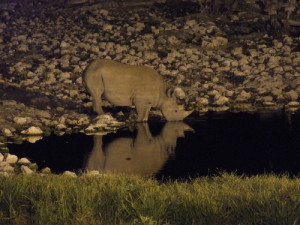Black Rhinos Facts
By Stuart Blackman – Rhinos are the archetypal bad-tempered loners -territorial, aggressive and famously myopic – that crash through life, with a reputation for charging at anything that moves (and sometimes even at things that don’t).
But it seems that we’ve got black rhinos all wrong. Or at least only half-right. And all it took to see them in a new light was to film them after dark. Remarkable footage captured by the Africa crew at a secret location reveals that, once the sun has set, black rhinos turn into party animals.
“This is a side to their behaviour that hasn’t been explored until now,” says director Simon Blakeney. “It was no secret that black rhinos are active at night, but we filmed things that hadn’t even been dreamed of.”
The location is secret for a very good reason. Black rhino numbers suffered a catastrophic decline during the 20th century. By 1995, only 2,410 animals survived – a reduction of 98 per cent since i960, largely a result of poaching. Since then, intensive conservation efforts have driven a steady but modest recovery; by the end of 2010, numbers had risen to 4,880. But poaching is still a major threat, a problem of which the film crew is painfully aware.
“While we were filming, rhinos were being poached at the rate of one a day in South Africa alone,” says Simon.
![Black Rhinos Facts]() MIDNIGHT ATTHE OASIS
MIDNIGHT ATTHE OASIS
Revealing that filming took place in the Kalahari Basin isn’t giving much away. This vast tract encompasses most of Botswana, much of Namibia and parts of South Africa, Angola, Zambia and Zimbabwe.
Equipped with the latest image-intensifying Starlight cameras, the crew pitched camp at a water hole, well off the beaten track, that rangers had told them was likely to be frequented by rhinos at night.
“We tried to be unobtrusive – though there’s a limit to how unobtrusive you can be with six or seven tents and a couple of vehicles,” admits Simon. But fears that their arrival would send wildlife running were quickly dispelled.
“Maybe because if s not on a tourist route – there’s no path or track to this place – the animals were incredibly trusting,” he says. “There were huge numbers – more giraffes than I’ve ever seen together, and hundreds of zebras.”
Lots of rhinos.
 “There were up to 16 at any one time, but it wasn’t the same 16 across the night,” he recalls. “As many as 50 animals would come and go – males, females and calves.” And they weren’t there just to drink. They were there to socialize: “It was like a party.”
“There were up to 16 at any one time, but it wasn’t the same 16 across the night,” he recalls. “As many as 50 animals would come and go – males, females and calves.” And they weren’t there just to drink. They were there to socialize: “It was like a party.”
And like any good shindig, it was a noisy affair. New arrivals were greeted enthusiastically: “They squeaked and squealed and skipped around. And roared – real guttural roars, like the dinosaurs in Jurassic Park.”
The crew filmed courtship, mating behaviour and even what appeared to be party games. “We saw one male pick up a pair of kudu horns and strut around with them balanced on his nose,” Simon says.
There were also the inevitable .run-ins with the neighbours. Staggering around in the dark, rhinos and giraffes, in particular, would bump into one another without warning, each spooking the other.
Even those inscrutable, beady eyes came alive. “Instead of being sunken into their sockets and hidden by wrinkles, they seem to open them wider at night,” Simon explains. “You could almost see the expressions on their faces.”
The trouble with parties is that there’s always a morning after. Could that be one reason why black rhinos don’t seem to be in the best of moods in the cold light of day?

